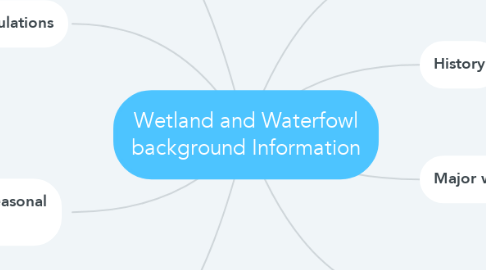Wetland and Waterfowl background Information
by Evan Tanner

1. introduction
1.1. - wetlands and water fowl are important to Michigan national heritage - Waterfowl relay on wetlands - Wetlands help humans by reducing floods
2. History
2.1. - Glaciers carved out the great lakes when the ice melt there was water ever where. - The Government and other people got rid of most of the wetlands today. - now to new laws some of the wetlands or safe.
3. Major wetland types
3.1. - A marsh has standing water just a few in or feet deep. - Marshes are critical to some fish species - Swamps are flooded woodlands. - Michigan trees are found in swamps.- Bogs are decaying vegetation forms mat and covers a pond. - acid bog is called a fen It has high nutrients level.
4. Why are wetlands important
4.1. - it produces more wild life and plants than any other Michigan habitat. - reduces flooding. - break down harmful stuff into non harmful. - help recharge ground level surprise - produces useful plants and game birds.
5. What are threats to wetlands
5.1. -wetlands Shirk and expanded or same natural for years and it still does it today -last century wetlands are decreasing by filling and draining by humans. -Also wet lands are decreasing by commercially, industrially, and residential expansion. Wetland have been reduce by 3 acres.
6. wetlands regulations
6.1. -Some wet lands you would need a permit to go. - wetland are often found in river flooding you could go in there without a permit. - you got to contact the DUI because you could run into an project for wetlands. - Michigan is a key state that protect their waterfowl population. - We have a lot of waterfowl in Michigan - Some waterfowl nest in the high land like the mallards and the Blue wing teal. -
7. Annual cycles and seasonal needs
7.1. - Food in the Wetlands make the ducks stop to eat - The wetlands give off rich protein and calcium - The waterfowl also rest in wetlands - ducks like wetlands and high lands - wood ducks come in march because they usually have a lack of protein. - a average clutch for wood ducks is 12 eggs.takes 28 days - blue winged tail eat portion less than 8 inches of water - They have a clutch size of 10 eggs. - Hens mallards like grassy areas - The nest would be 1 mile away from the wetlands - the clutch would be 9 to 10 - It takes 25 days to hatch.
8. Management and considerations
8.1. To have a duck in your yard you would have to protect and maintain the habitats and at least have to be 100 feet wide and grassy area for nesting. - mow grass between July 15 and Aug 30 - Maintain large and mature trees like maple trees - for nesting you would have cover for nest - Minimize disturbance to your wetland - have many wetland types to


